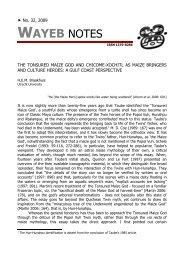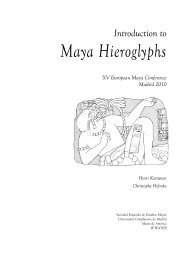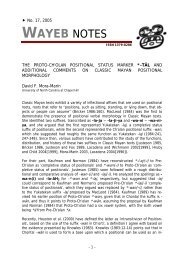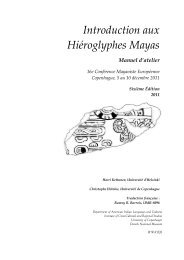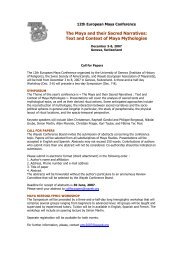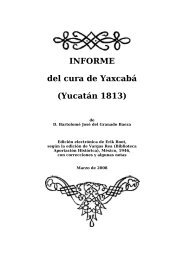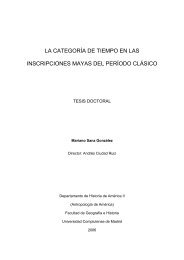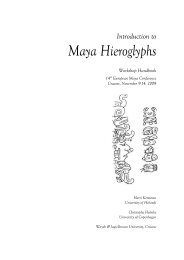Introduction to Maya Hieroglyphs - Wayeb
Introduction to Maya Hieroglyphs - Wayeb
Introduction to Maya Hieroglyphs - Wayeb
You also want an ePaper? Increase the reach of your titles
YUMPU automatically turns print PDFs into web optimized ePapers that Google loves.
Kettunen & Helmke 2011<br />
Appendices<br />
(3) MEDIOPASSIVE: CVC-Vy-ABS<br />
In the mediopassive voice (middle voice), the agent is completely deleted and is <strong>to</strong> be unders<strong>to</strong>od only in general<br />
terms (if indeed at all). The patient becomes the subject of the verb. In other terms, the verb in the mediopassive<br />
voice has stative meaning, and the agent (or ac<strong>to</strong>r) is not expressed.<br />
TZUTZ-yi ju-bu-yi chu-ku-yi<br />
tzutzuy jubuy chukuy<br />
tzutz-uy-Ø jub-uy-Ø chuk-uy-Ø<br />
“got finished” “got deposed” “got caught/seized”<br />
Example:<br />
chukuy Aj Ukul<br />
“Aj Ukul got caught/seized”<br />
(4) ANTIPASSIVE: CVC-VVw(?)-ABS (Early Classic)<br />
CVC-Vw-ABS (Late Classic)<br />
Antipassive voice is a voice in ergative-absolutive languages, like the <strong>Maya</strong> languages, in which a noun phrase<br />
has absolutive case instead of the “normal” ergative case. A noun phrase normally having absolutive case is<br />
marked as an oblique or an indirect object. The verb in antipassive constructions has formal characteristics of<br />
intransitive verbs in <strong>Maya</strong> languages. In <strong>Maya</strong> hieroglyphic writing there are three distinct types of antipassive<br />
constructions: (a) absolutive antipassive, (b) object-incorporating antipassive, and (c) agent-focusing<br />
antipassive. All of them delete the patient, and therefore leave the agent as the subject of the verb. Antipassives<br />
can only be made from transitive verbs (root transitives or derived transitives), and they are all distinguishable<br />
morphologically by the absence of the ergative pronoun u- and the presence of characteristic suffixes.<br />
TZUTZ-wi<br />
tzutzuw<br />
tzutz-uw-Ø<br />
“he/she finished”<br />
TRANSITIVE VERBS: (non-CVC)<br />
ACTIVE VOICE:<br />
ERG-VERB-V-ABS<br />
yi-IL-a u-TZ’IB-ba<br />
yila<br />
utz’i[h]ba<br />
y-il-a-Ø<br />
u-tz’ihb-a-Ø<br />
“he/she saw [it]”<br />
“he/she wrote/painted [it]”<br />
PASSIVE VOICE:<br />
VERB-n-aj-ABS<br />
tz’i-bi-na-ja<br />
tz’i[h]bnaj<br />
tz’i[h]b-n-aj-Ø<br />
“[it] was painted”<br />
This construction (save the reconstructed -h-) is the one <strong>to</strong> be found on innumerable texts on <strong>Maya</strong> polychrome<br />
ceramics (note that -n- is the true passivizer of non-CVC constructions).<br />
68/154



